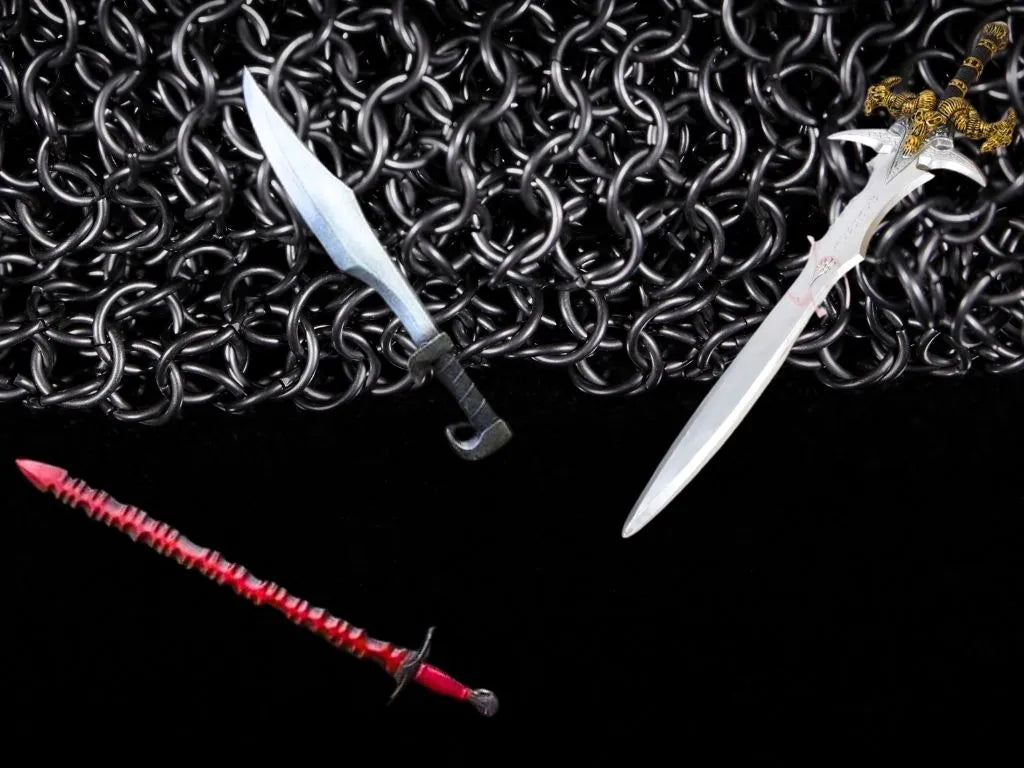




Roman legionary gladius with scabbard, 1st century 0180010200
Choose options
Roman gladius Mainz-Fulham type with scabbard
The Gladius, the standard weapon of Rome's legionaries between the 3rd century BC and the 3rd century BC, has been used in many different variants over the centuries. Although primarily designed for stabbing, the feared Roman short sword was also an extremely effective cutting weapon. However, over the course of the Middle/Late Roman Empire, it was gradually replaced by the longer Spatha.
Although the Roman sword offered here is not an individual replica of an archaeological find, it is based on the Gladii, which was built by Roman legion soldiers in the first half of the 1st century. The broad, double-edged blade with a flat, diamond-shaped cross section is forged from EN45 spring steel (neither hardened nor heat-treated). With its parallel, straight edges and long, pointed placement, it corresponds to the blade of a classic Gladius of the Fulham or Mainz-Fulham type, which is classified as a transitional type between the Mainz type and the later Pompeii type (or as a variation within the Mainz Group). The blades are not sharpened and the continuous blade rod is screwed all the way to the end of the handle (brass threaded nut). The handle is made of bone, parier and knob of wood. The stop piece is fitted with a brass plate on the blade side.
The Roman single-handed man's scabbard with brown leather/wood scabbard is supplied with ornate brass fittings (an openwork mouth-plate, horizontal straps with support rings and a frame or a continuous side border which is closed by a place-button). The front panel of the mouth-plate displays a geometric sun-shaped revolution motif and the V-shaped position band is decorated with a pattern of stylised and symmetrically arranged turns and surmounted by a palmette. The vaginal fittings are inspired by historical finds, in particular by the remains of a 1st century sword scabbard, which was recovered from the Porto Novo shipwreck near Porto Vecchio (Corsica) and was also identified as a transitional type due to its shape, size and ornamentation.
It should be noted that this sword is not suitable for display combat. It is available as a collector's item or decorative object designed and also very suitable as an accessory, for example to complete your costume.
Details:
- Material: EN45 spring steel blade (carbon steel, not stainless), bone handle, wooden parier and knob, clamping nut and brass handguard insert
- Total length: approx. 72cm
- Blade length: approx. 52 cm
- Blade thickness: approx. 3.8 mm / 2.8 mm (cutting edges approx. 1 mm)
- Handle length: approx. 20 cm (handle approx. 9.5 cm)
- Max. Blade width: approx. 5.3 cm
- Center of gravity: about 10 cm before the calf
- Incl. Wooden case with genuine leather cover and brass fittings
- Weight without cover: approx. 0.65kg
- Weight with cover: approx. 1.1kg
The above specifications may vary slightly from copy to copy.
The steel used here is not stainless and may show slight signs of corrosion. We recommend that you regularly care for the blade and the sheath, for example with ballistol, a universal oil that is ideal for preserving steel products.
At EspadasYMás we have the best Roman swords of all kinds such as the Gladius, as well as related swords such as the Iberian Falcata or the Celtic Spatha. We also have medieval swords, famous swords such as the Tizona or the Cid swords. Fencing swords, bastard swords, etc.
We have the best Roman swords in our store, you can even find scabbards for your collection. Don't hesitate and buy your Roman sword in our store.
+5415 Reviews
HaritzEs muy divertida para jugar
AlmudenaExcelente producto, muy muy muy recomendable para los seguidores de la saga
AketzaBuen producto, tal y como esperaba. Lo recomiendo
AarónUna espada muy bonita con materiales muy buenos y un precio increíble en relación a la calidad.
AarónMuy buen producto, una calidad perfecta y se nota que está hecho a mano. Completamente recomendado
Juan Antonio100% recomendable cada detalle al milímetro
MariaTodo genial. Envío rápido y el producto de calidad
HectorRecreación increíble de una de las armas que me producen más nostalgia de mi videojuego favorito. Si te gusta Final Fantasy VIII, merece la pena, si te gustan los modelos exóticos de espadas, también.
SAULExelente regalo para fans de Kimetsu no Yaiba. Estampado de gran calidad.
SAULPlaca de madera cortada y grabada al laser con 2 imanes en la parte posterior. Perfecto para regalo.
Free shipping
The entire Iberian Peninsula from €60 (*Does not include islands) and shipping worldwide, check our rates
Customer service
We are available from Monday to Friday to answer your questions.
Secure Payment
We comply with all regulations to ensure Secure Payment
Contact us
Need to contact us? Just email us at info@espadasymas.com











